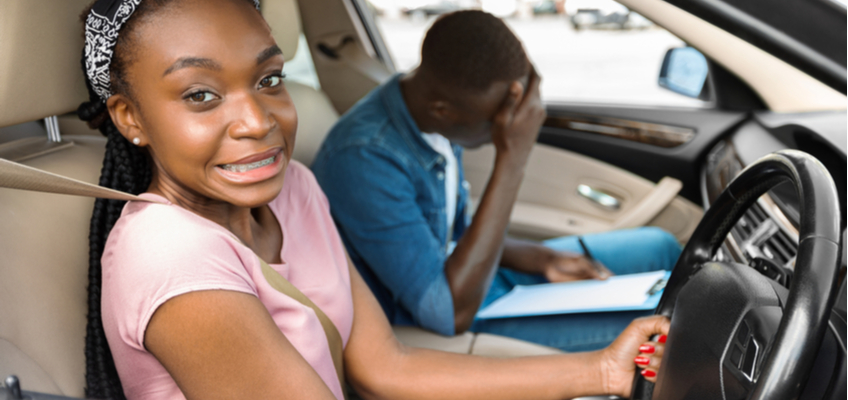If your driving test is coming up, it’s natural to worry about making mistakes. But here's the good news: many learners make minor driving faults, and you can still pass.
This guide will break down everything you need to know about major and minor faults, how many are allowed, and tips to improve your driving performance before test day.
In This Guide:
What counts as a minor fault in a driving test?

A minor fault, also known as a driving test minor fault, is an error that doesn't pose immediate danger to other road users and is not classified as serious or dangerous or affect driving safety, but still shows a lack of full control or awareness. Minor faults highlight areas where your driving skills could be improved.
Examples of Minor Driving Test Faults:
- Stalling or poor use of clutch/biting point
- Touching the kerb when turning or parking
- Driving too slowly in normal traffic conditions
- Hesitation at busy junctions
- Incorrect or missing signals
- Not checking mirrors regularly or blind spots
- Forgetting weather-based adjustments like wipers or headlights
How many minors are you allowed in your test?
You can get up to 15 minor faults, which is considered many minors, and still pass the DVSA driving test. Once you reach 16, you automatically fail.
However, making the same fault three or more times in one category, such as missing appropriate signals may be considered a major fault, resulting in an automatic fail.
There are 28 assessment areas on the driving test sheet, each related to driving safety, control of the car, and response to road users and traffic conditions.
How to avoid minors in your driving test
According to data from the DVSA, only around 1% of the population who pass their test will do with zero minors. It is extremely rare to get no minor fault at all. So, by all means aim for top of the class, but we urge you to not be disheartened if you get minor faults– you're in the vast majority if you do!
However, like with any test there are a few ways to put yourself in the best position to bag yourself a clean score:
- Practice makes perfect: If you know parallel parks aren't your strong point, then don't just pray you're not asked to perform one.
- Revise your theory: There's a reason you do a theory test before taking to the road, and it's the application of all that knowledge which will set you up for success.
- Bring it back to basics: Mirror, signal, manoeuvre. Remain vigilant and double check for all hazards before you drive off. Oh, and it pays to be blatant with your checks: your assessor may not see a quick side glance of the eye when you look in the mirror – make it obvious what you're doing.
- Have an open dialogue with your instructor: Ask them for regular feedback on your progress while you're learning, as well as common minors that occur on test day.
- Personal prep: Get a good night's sleep, wear comfortable clothing and sturdy clothes. Arrive early to ensure you're not rushed.
- Be calm: Try not to let nerves get the better of you. Take a few moments before you set off to breathe and remember it's completely normal for people to make mistakes.
What is a major fault in a driving test?

A major fault is categorised as either a dangerous or serious fault. A serious fault can predicate an actual danger as it's something which has the potential to cause danger. A dangerous fault involves actual danger to you, the examiner, the public or property.
If a driving test major fault occurs, unfortunately you'll receive an instant fail, though will still be expected to continue with your test and await the assessor's report.
Examples of serious and dangerous faults include:
- Failing to stop at traffic lights or traffic signs
- Lack of observation at junctions or pedestrian crossings
- Poor control of the vehicle, such as losing control of the steering wheel
- Moving off without checking blind spots
- Not responding to road signs
- Speeding
Any single major fault is considered an instant failure of the test. Similarly, as we mentioned earlier, a major fault can also be made up of three minors in the same category – a signal of repeatedly making the same mistakes.
How many majors are you allowed?
None. As a major is defined as a serious or dangerous fault, unfortunately receiving one of these will result as an automatic fail.
While a fail is undeniably disappointing, don't be too hard on yourself. A fail test is a learning opportunity. According to the government website, data from the past ten years shows that over 50% of people don't pass their driving test first time. If you do fail, then ask your instructor for constructive feedback and ask them to explain the reason why your major fault resulted in a fail from a safety perspective. That way you'll be more prepared for next time.
How to avoid common driving test mistakes
Even experienced drivers can make small errors. But by preparing well in your driving lessons, you can improve your driving skills to keep minor faults to a minimum and avoid test major faults altogether.
Key Tips for Learner Drivers:
- Practice consistently: Focus on weak spots, especially parking, mock tests, and manoeuvres
- Understand theory: Your practical test is the application of your theory, so make the knowledge count.
- Use basic routines: Mirror, signal, manoeuvre – repeat and make your checks obvious
- Check your mirrors frequently: Before changing lanes, turning, or braking
- Stay aware of road signs and hazards, especially in unfamiliar areas
- Talk to your driving instructor: Get regular feedback and review your performance
- Don’t rush: Arrive early, stay calm, and take a moment before setting off
Do minors affect your car insurance premium?
No, they don't. Whether you get 15 minors or 0, a pass is a pass and insurance providers don't ask for a report.
However, it's still useful to be aware of what you received minor driving faults on so as to avoid making those mistakes on the road. For example, if you fail to observe traffic signals and signal incorrectly, resulting in a potentially dangerous situation or an incident, you'll have to claim on your insurance which'll hike up the price.
Young and inexperienced drivers face the highest premiums. If you know you're a responsible driver, consider taking out black box insurance to prove this, as it's one way to bring down your quote.
Have you recently passed your driving test? Start your car insurance comparison today to find yourself the best deal on the market.






